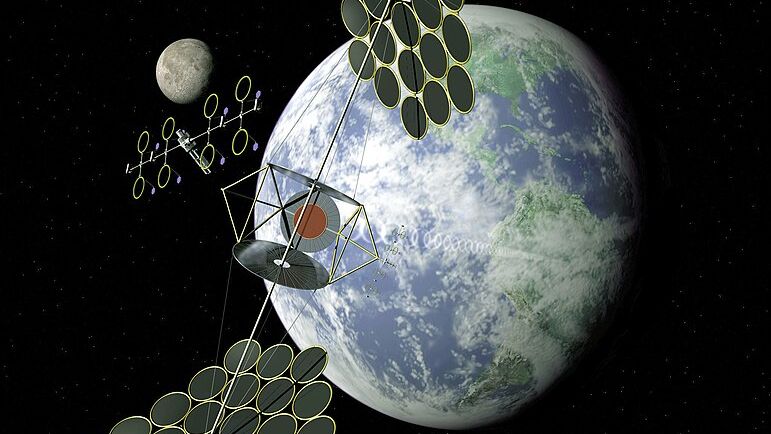Photo voltaic-powered lasers that run on the photosynthetic equipment of micro organism may at some point present a low mass, easy and sustainable technique of offering energy in house, changing the same old heavy lenses and sophisticated electronics that are not very cost-effective to launch.
“Our plan is to make use of photosynthetic buildings extracted from micro organism, and the concept is that you could develop them and hold replenishing materials, you need not preserve a provide line from Earth,” Erik Gauger, a professor of photonics and quantum science at Heriot Watt College in Edinburgh and chief of the brand new undertaking, informed Area.com.
Because the variety of satellites in our planet’s orbit continues to develop, scientists have began to concentrate on present energy for these satellites in the long term. With higher energy mechanisms, it is possible we’ll be capable of improve the lifespans of spacecraft. One potential resolution is energy beaming — utilizing photo voltaic arrays to transform the solar‘s gentle into lasers or microwaves that might be beamed in direction of a stricken satellite tv for pc to energy it up through a receiver on the facet of that satellite tv for pc.
Early in 2023, the primary power-beaming checks from house efficiently transmitted low-power microwaves, amounting to no quite a lot of milliwatts, from the Area Photo voltaic Energy Demonstrator satellite tv for pc to a floor station at Caltech. In 2025, Japanese researchers goal to realize a comparable feat.
Associated: Scientists beam solar energy to Earth from house for 1st time ever
Nevertheless, photo voltaic arrays might be massive and hulking, and their advanced designs and circuitry would imply any orbiting photo voltaic farms would require common alternative or restore. It is in all probability higher to discover a extra sustainable and self-sufficient methodology, and researchers engaged on the APACE undertaking assume they’ve an answer. With this undertaking, they search to adapt the molecular buildings that enable micro organism to photosynthesize towards a laser system that may very well be utilized in house.
“Our key concept is to switch the concentrating optics with the photosynthetic antenna complexes,” stated Gauger.
APACE includes researchers from the U.Ok., Germany, Italy and Poland, and is being funded by the European Innovation Council and Innovate U.Ok. to the tune of 476,000 euros for section 1. Gauger, as APACE’s undertaking supervisor, defined what section 1 includes: “For the second, attempting to do the proof of precept on Earth in our laboratories, and we will probably be testing it underneath simulated house situations in direction of the top of the undertaking.”
This may see the crew extracting and experimenting with the molecular antennas to find out which species of micro organism produce probably the most usable ones for solar-powered spacecraft. The researchers may also discover nano-engineering synthetic antenna buildings to match how environment friendly and usable they’re in comparison with the natural selection.
Some extremophile micro organism, as an example, are in a position to thrive in very low-light situations by having molecular antennas which can be in a position to take up virtually each photon that falls on them and direct the power to wherever it must go within the micro organism’s mobile biology.
The APACE undertaking is seeking to adapt such micro organism, extracting their antennas and utilizing them to soak up daylight. The photo voltaic power would then be diverted into the laser mechanism. Lasers function through the use of a “achieve medium” contained in the laser cavity. When photons work together with the achieve medium they generate extra photons — what is named stimulated emission — amplifying them, till there’s sufficient to supply an intense and coherent beam. The crew is probably utilizing neodymium nano-crystals because the achieve medium, and daylight gathered by the micro organism’s photosynthesizing antennas will present the photons to get the laser began after which preserve its exercise.
The micro organism may very well be grown in house, maybe on the Worldwide Area Station or on a satellite tv for pc, eradicating the necessity for continuous launches from Earth to take care of and exchange outdated photo voltaic arrays.
Nevertheless, as Gauger stated, really launching a prototype into house would require much more funding and rely upon section 1 being profitable.
At this stage, the benefits of a profitable model of the prototype aren’t essentially effectivity, though which may come later. A typical silicon-based photo voltaic panel converts daylight into electrical energy with an effectivity of about 30%, producing a couple of hundred watts per sq. meter. Though the micro organism from which the photosynthetic antennas are being tailored have an effectivity approaching 100%, the natural photo voltaic arrays being designed as a part of the APACE undertaking will solely handle to transform 10–15% of daylight into energy.
Though that is a lot poorer than what nature does, “Possibly that is not shocking since evolution has optimized it over an extended time,” stated Gauger. “We do not fairly know precisely why photosynthesis is as environment friendly as it’s, and we’re not nearly as good at transferring round power on the molecular stage with synthetic buildings, and our supplies aren’t as strongly absorbent.”
Limitations apart, APACE will nonetheless present important advances. “It is a very totally different structure,” stated Gauger. With a typical silicon-based photo voltaic cell, the power is collected however then one thing must be executed with it, utilizing digital elements, to show it into one thing usable. “In our case, we are attempting to do that with out something electrical — and not using a battery; with out circuitry.” The organic, photosynthesizing equipment robotically converts the daylight right into a laser without having all that equipment.

